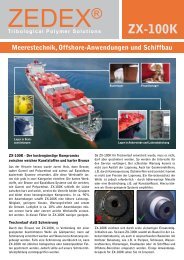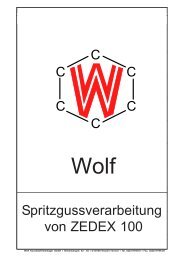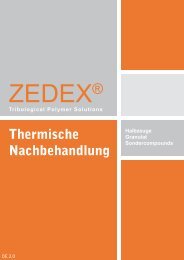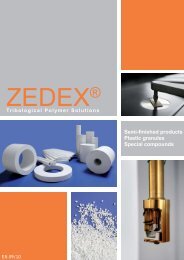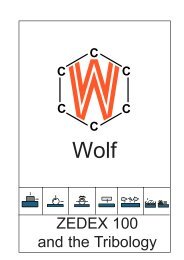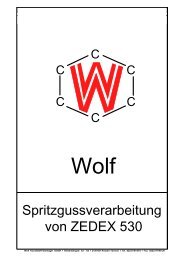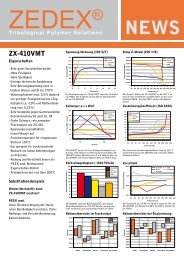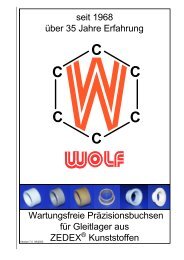CCCCCC6.3. Surface quality of the metal slidingsurfaceLubrication7.2. Influence of temperature on thelubricantsPrefaceIn general, it applies to all alloys of the ZX-series: thesmaller the roughness of the metal sliding surface, thelower the wear on the plastic sliding surface.Furthermore, you must take into consideration that themachining grooves which resulted from the machiningof the metal sliding surface possibly run in slidingdirection.Owing to the feed wear which enables a smoothing ofthe metal sliding surface, a regular sliding with minimumwear is already possible, when the surface quality ofthe metal sliding surface 2,0 µm Rz is not exceeded.These surface qualities should always be applied, whenslide <strong>bearings</strong> of the ZX-series must achieve a very longworking life.In practice, however, such high surface qualities are oftennot applied, because either the considerably highproduction cost is economically not justified or theextremely high life span of the bearing is not required.In the field of mechanical engineering, a compromisesurface roughness of the metal screw of 4 µm Rz hasgained acceptance regarding production cost andworking life of the slide bearing. This is why all laboratoryand component tests quoted in this brochure have beencarried out with a surface roughness of 4 µm Rz of themetal sliding surfaces.7.LubricationA lubrication of slide <strong>bearings</strong> made from ZEDEXmaterialsis principally not required.However, the efficiency of the bushings can be improvedwithout negatively influencing the load-carrying capacityof the bearing.Moreover, an unique initial lubrication may improve thefeed performance of the slide bearing bushes.7.1. Influence of lubricationÄ reduction of frictionÄ reduction of wearÄ lightening the feed phaseÄ avoiding tribocorrosionÄ noise reductionÄ reinforcement of shock absorptionÄ cooling the slide bearing by the lubricantÄ protecting the metal parts against corrosionÄ sealing the bearing seatIn most cases of application a lubrication of the ZXmaterialshas turned out to be superfluous, often anomission of lubrication has even been required.7.2.1.ViscosityWith increasing temperature the viscosity of lubricantsis reduced. They show low viscosity.Depending on the chemical composition of the lubricantthe influence of temperature is more or less strong. Attemperatures of 200 °C many lubricants only achievethe viscosity of water, that means they are very runny.Owing to this viscosity reduction typical problems canarise, especially in the field of hydrodynamic lubricationand flat-run behaviour.7.2.2.Surface tensionLubricants have different surface tensions depending ontheir chemical composition. The surface tension is ameasure of the wetting properties of the lubricants onthe respective bearing or screw material. A low surfacetension enables a very good wetting, but also a creepingand migration of the lubricant out of the bearing seat.Whereas a high surface tension on the one hand createsdrooling and bad wetting, but on the other hand reducesthe lubricant dissipation and guarantees lubrication duringthe whole working life. Apart from the dependence onthe lubricant, the surface tension is strongly dependenton the temperature. With increasing temperature thesurface tension decreases. The wetting becomes better,the bonding becomes worse. In combination with thedecreasing viscosity due to the increase of temperature,oils can quickly moisten wide ambient ranges of <strong>bearings</strong>eats at high temperatures. This causes a reduction ofthe lubricant quantity inside the bearing gap and thereforea reduction of the working life and/or a noise increase.These processes are irreversible. After the oil has chilled,the migrated area remains wet. The oil does not flowback into the capillary gap of the bearing. Owing to thefact that this process carries on with every new heatingup,you have to take care when operating at hightemperatures.Normally, synthetic lubricants as for example ester arewell adhesive at room temperature. However, attemperatures exceeding 100 °C the surface tensiondecreases to the range of silicone oils. In this case theapparent surface tension of the solid is higher than thatof the lubricant. This enables a complete wetting of thereachable surface element. The component and casingsurfaces are coated in this case with a closed lubricatingfilm, which can cause drastic lubricant dissipationsinside the bearing itself. Due to these migration andwetting processes, great distances can be covered.Leakage currents of some ten centimetres have beenascertained.This also enables lubricants to advance to componentranges, where they are unwelcome, e.g. electirccontacts, casing sealings, electronic components,optical systems etc. In any case this creeping causes<strong>Wolf</strong> <strong>Kunststoff</strong>-<strong>Gleitlager</strong> <strong>GmbH</strong> • Heisenbergstr. 63 - 65 • 50169 Kerpen-Türnich • Tel. 02237/9749-0 • Fax. 02237/9749-20ContentsMaterialoverviewIndex <strong>Slide</strong> <strong>bearings</strong> <strong>Slide</strong> <strong>bearings</strong> Conditions ofTribologyMathematical Design(with collar) (cylindrical) installationexample guidelines20
CCCCCClubricant dissipation and therefore deficient lubrication.7.2.3. EvaporationAll lubricants have a steam pressure depending on theirchemical composition. That means, every lubricant emitsin certain limits and to a certain extent molecules to thesurrounding atmosphere. This process is influenced bythe ambient pressure and the ambient temperature. Alow ambient pressure leads to a quicker evaporation. Insome cases the boiling range of lubricants with a lowviscosity can be exceeded. But modern lubricants canachieve considerable evaporation rates also withoutboiling the fluid. These evaporation rates can causelubricant dissipations of several percent per day, if thesystems are not closed and sealed. Apart from thetemperature and the atmospheric pressure, this processdepends on the free surface. Here are especially sensitiveoil films developped by means of migration. In thiscase a very big evaporated area faces a very low quantityof lubricants. This leads to very quick evaporationprocesses in these ranges. The reinforcements into theevaporated surfaces ensues by means of capillary effectsreleased inside the roughnesses of the surfacesthemselves.7.2.4. AgeingWith increasing temperature lubricants becomechemically more reactive in the presence of oxygen. Thechemical processes which run very slowly at roomtemperature are drastically speeded up with increasingtemperature. Here applies the van t´Hoff rule, accordingto which the reaction rate of a chemical reaction isincreased two to four times by means of a raising oftemperature by 10 K. Thus the reaction rate is 2 18 (260000)times quicker at 200 °C than at 20 °C. In practice thismeans that when operating at room temperature weachieve a working life of 20 years, whereas at atemperature of 200 °C we achieve a working life of almost1 hour. The lubricants change their chemical composition,the viscosity and the neutralising or acid value increaseand additives are decomposed in every case. Especiallythe viscosity increase (oxidative polymerisation)drastically changes the characteristics of the lubricant.Some lubricants which are long-term exposed to highambient temperatures are transformed into stickymaterial, rubber-like substances or tar- and asphalt-likeproducts. These lubricants are consequently no longererational for bearing systems at low temperatures.7.2.5. Yield point of greasesWhen operating with greases at high temperatures, thethickener which is in most cases a metal soap starts tomelt. The lubricant loses its internal structure andbecomes completely liquid. In general this process isreversible, however, operations at temperaturesexceeding the melting point of the thickener may createspontaneous flat-running.LubricantsHigh temperature applications thus require theconstructive guarantee that sufficient quantities oflubricants are provided in the area of tribological stressedelements.We recommend the constructive installation of oil poolsand oil barriers or the epilamisation of the componentsurfaces in order to reduce the migration of the oil out ofthe bearing seat.7.3. Lubricants7.3.1.Lubricating oilsAccording to their origin lubricants can be subdividedinto:- mineral oils- animal and vegetable oils- synthetic oils- other, e.g. waterMineral oils which can be extracted from petroleum andpartly from coal have the biggest importance. Theyconsist of paraffine, naphthene and aromatic solvents.Animal and vegetable oils such as castor oil, fish oil,olive oil a.o. are used for special applications, e.g. inthe field of precision engineering.The lubricants must have a whole lot of physical andchemical properties in order to be able to fulfil theircomplex tasks.The viscositiy is of decisive importance when achievinga hydrodynamic or elastohydrodynamic lubricatingcondition; it is a measure of the internal friction of thelubricating oil. Often so-called additives are added tolubricating oils in order to make them able to fulfil theirfunction when operating subject to high, complex stressover a long-term period. The most important lubricantadditives are quoted with their tasks, active substancesand modes of action in table 8.<strong>Wolf</strong> <strong>Kunststoff</strong>-<strong>Gleitlager</strong> <strong>GmbH</strong> • Heisenbergstr. 63 - 65 • 50169 Kerpen-Türnich • Tel. 02237/9749-0 • Fax. 02237/9749-20PrefaceContentsMaterialoverviewIndex <strong>Slide</strong> <strong>bearings</strong> <strong>Slide</strong> <strong>bearings</strong> Conditions ofTribologyMathematical Design(with collar) (cylindrical) installationexample guidelines21



